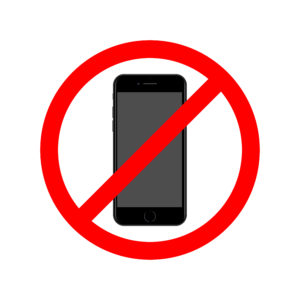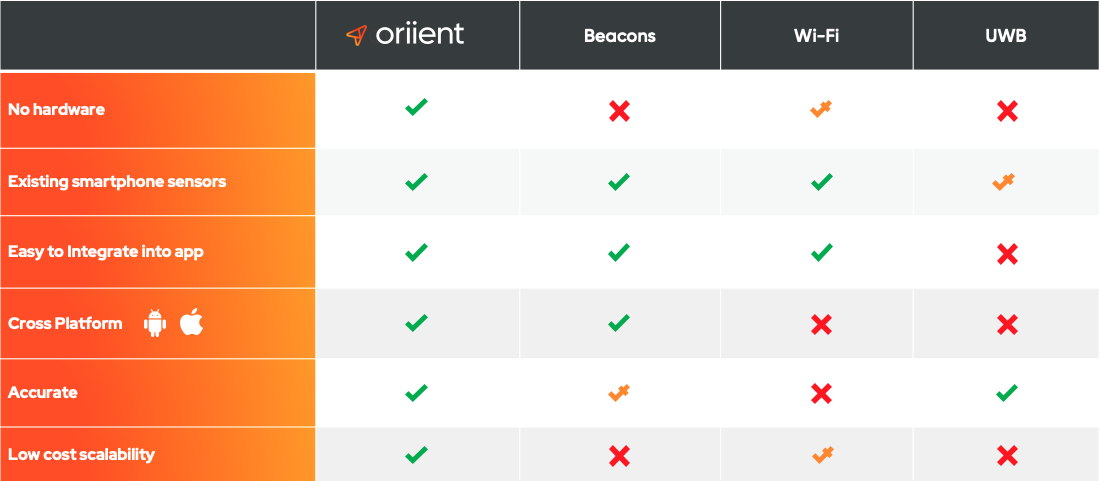Comparing Indoor Positioning Technologies: Which one is Right for You?
Considering implementing an indoor positioning system in your buildings for use on a mobile app?
Smart choice – not only will it dramatically enhance visitor experience, but it also delivers invaluable analytical data, and new location based marketing opportunities (find out more about what location services can do inside buildings and stores here).
There are lots of different types of technology being used to power indoor positioning solutions – and they all vary in terms of cost, accuracy and capabilities.
So how do you cut through all the tech specs and get down to which system suits your needs?
Let’s outline the practical functionalities of the different systems that offer solutions for end-user’s mobile phones, based on 3 key points:
- Availability – does the system require hardware installation or infrastructure, does it need maintenance, and can it run on most mobile phones?
- Accuracy – how precise is the positioning (level of granularity in a space), and are there any issues with interference (like diminished performance due to multiple users or physical obstacles)?
- Cost – what is the business model? CAPEX vs. OPEX? Is there a big investment required to scale the solution to many locations?
Get the full report
BLE Beacons
This solution for indoor positioning involves the installation of radio transmitters (typically battery-powered) throughout a space. These transmitters (beacons) send out Bluetooth Low Energy (BLE) signals, and locate a user’s position via trilateration. The size of the building and layout of signal obstructions (furniture, people, etc.) will determine the number of beacons required for a particular space. Actually, correctly selecting beacons placement is an art in itself. The more beacons deployed in a space, the more accurate the positioning. A typical grocery store, for example, can expect to install 1 beacon every 10 feet/3 meters in order to achieve 6 foot/2 meter accuracy.
Pros
- Platforms. Beacon technology works on both iOS and Android devices.
Cons
- Accuracy. Dependent on the number of beacons deployed – if too few are installed, the accuracy will decline.
- Hardware. While beacons themselves are relatively cheap ($5-$15 per beacon), in order for beacons to achieve their maximum accuracy, expect to install at least 1 beacon per 5 m2 – which can really add up in large spaces.
- Interference. Beacon signals are easily interrupted by items like shelving and furniture, and especially the human body.
- Cost and Maintenance. Since beacons are usually battery-operated, replacing batteries and updating devices should be an expense building owners take into account. There will always be a large investment when using beacon technology, for the installation and setup of the beacons, and later for maintenance.
Wi-Fi
WiFi technology finds user positions by determining the strength of the signals between user devices and available hotspots and routers. Unfortunately, systems using WiFi signals experience low accuracy, usually due to signal interruptions and “dead spots”.
Pros
- Existing hardware. WiFi infrastructure, like hotspots and routers, already exists in a lot of buildings.
Cons
- Accuracy. WiFi only works well when there are no obstructions to its signal (like walls, furniture, shelves or people). But even without any signal blockage, WiFi only achieves 10-20 meter accuracy in typical real-world environments.
- Platforms. Indoor positioning via WiFi is only available to Android users, and can’t be used for an iOS app (other than Apple’s own apps).
- Hardware. Despite being able to use existing WiFi infrastructure, additional or upgraded gateways are usually required to experience even minimal accuracy. The vast majority of locations don’t have full WiFi coverage, and WiFi positioning actually requires that every spot be covered by 3-4 access points.
- Pricing. Due to the need for expensive devices and heavy installation to make the system operative, companies offering positioning via WiFi charge a large one-time set up fee, in addition to the ongoing monthly service.
Get the full report
Ultra-Wideband (UWB)
Ultra Wideband technologies use transceivers, placed throughout a building, that send out radio signals to triangulate a user’s position using time-of-flight measurements. These systems require very specific hardware to be installed throughout a space, and are only compatible for use on the latest iPhone models.
Pros
- Accuracy. Indoor positioning systems that use UWB are capable of achieving very high accuracy (up to 1 feet / 30 cm).
Cons
- Hardware. Implementing a UWB-based system requires extensive, expensive hardware installation.
- Platforms. Only available on iOS – iPhone models 11 and newer, which excludes most users.
- Interference. While UWB beacons are less susceptible to interference than BLE beacons, they require that each position in the space have line-of-sight to at least 3 beacons. This is a challenge in most environments – leading to a heavy installation burden.
- Business Model. Since using Ultra Wideband technology for indoor positioning is reliant on costly gateways that require electric wiring and installation throughout a location, a heavy investment should be expected, in addition to a monthly service fee.
GeoMagnetic Technology
Systems that use geomagnetic technology utilize the unique distortions in earth’s magnetic field created by every building. By learning the unique magnetic field landscape of a building, sensors that exist within common smartphones can be leveraged to achieve very accurate positioning. Geomagnetic technology completely eliminates the need for hardware installation, as accurate positioning can be achieved using existing smartphone sensors and Earth’s magnetic field is already everywhere
Pros
- Accuracy. 3 feet/1 meter accuracy with Oriient’s advanced algorithms.
- Hardware. No setup investment – the benefits of indoor positioning can be unlocked conveniently with just a smartphone, similar to how we use GPS outdoors.
- Platforms. Both Android and iOS users can utilize the service.
- Interference. Is not affected by other users or physical obstacles, because it doesn’t use radio signals.
- Business Model. Companies like Oriient offer indoor positioning as a service (SaaS model), without the need for a CAPEX investment for setup.
Cons
- Price. For very small spaces, or those that require less accuracy, WiFi or BLE systems are usually good enough, and might even be more cost-effective.
Get the full report
Visual Positioning
Visual positioning, as its name implies, relies on visuals to provide indoor positioning. using the camera, this solution creates augmented reality (AR) experiences. This first requires a visual capture of the area, in 3D, which is the basis of the map.
Pros
- No Hardware. The solution runs on the end-users devices.
- Platforms. Both iOS and and Android users can use the solution.
Cons
- Location Mapping. All people or items that may interfere with navigation must be removed during the initial filming process to map out the area.
- Interference. Is affected by other users or physical obstacles.
- Ease of Use. Users must hold their phones upright at all times to use the solution.
- Device Specification. The solution works best with high-end devices.
- Battery. Power consumption is significant, as the solution uses the camera and screen at all times.
Fusion and Other Technologies
Fusion systems use a combination of the above technologies to achieve positioning. Despite using a variety of technologies, these solutions still rely on hardware, meaning that they require installation and maintenance. Accuracy via a fusion system varies from 3-10 feet / 1-3 meters, which is something to keep in mind when assessing your needs.
Beyond Fusion technology, there are a few other niche technologies available – find out more about them by signing up for our detailed report below.
Pros
- Accuracy. While not always the case (see Interference below), fusion systems can achieve decent accuracy.
- Platforms. Indoor positioning via a fusion system is available to both Android and iOS users (depending on which combination of technologies is used).
Cons
- Hardware. In order to use positioning via a fusion system, beacons gateways, or both will be necessary.
- Interference. As aforementioned, interference issues can affect accuracy of positioning.
In the end, choosing an indoor positioning system depends mostly on your buildings’ needs and how you plan to use the technology. If you need a solution for a large space or plan to scale up to multiple locations, choose Oriient’s hardware-free Indoor GPS.
Oriient is compatible with all shopping environments and works in all stores, on all phones, and supports all holding patterns. Watch this video and see how our robust solution can operate in all shopping scenarios.
Click here to learn more about what you can do with Oriient IndoorGPS.
Oriient assumes no responsibility or liability for any errors or omissions in the content of this document, and for any potential business losses as a result. The information contained in this document is provided with no guarantees of completeness, accuracy, or timeliness and without any warranties of any kind whatsoever, express or implied.






